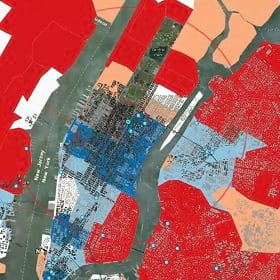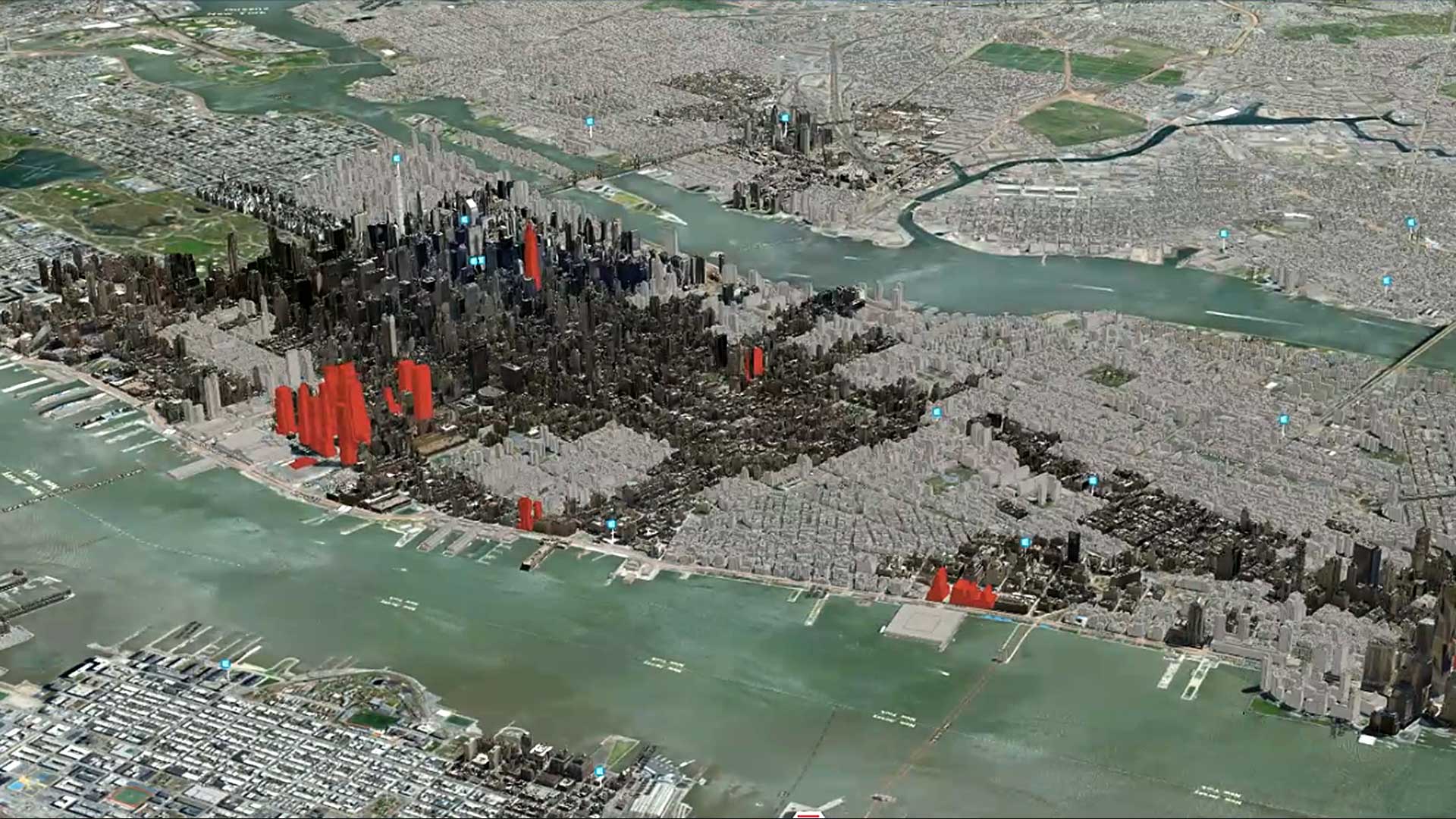As commercial real estate firms grapple with economic and industry changes—from coworking spaces to resilient buildings to the coronavirus-inspired trend toward contactless commerce—CRE leaders are finding new ways to bring buildings and markets alive for clients. This shift starts with a modernized approach to data and analysis.
Cushman & Wakefield, one of the world’s largest commercial real estate firms, with approximately 53,000 employees in 400 offices around the world, has built its client list over more than a century in business. The list includes major law firms, financial institutions, retailers, banks, professional services firms, and hundreds of energy companies—virtually any company that needs space to run commercial or industrial operations. Those clients expect the latest information and analysis on markets and properties, and they want to receive it through the kind of data-rich, visual experience they enjoy on their mobile devices.
To meet those expectations, Cushman & Wakefield recently undertook a digital transformation of significant scale. Through a combination of 3D tools, location intelligence technology, market data, and modern user interfaces, the firm is empowering its brokers to show clients what’s next in real estate, business, and markets around the world.
At the heart of the transformation is a system called PRISM, created by the company’s Technology & Data Solutions group. The client-centered app is powered by a geographic information system (GIS), and helps Cushman & Wakefield brokers forge an advisory role with clients, according to Chris Kolodz, the company’s head of client technology solutions.
“PRISM has improved the relationship,” Kolodz says. “Now clients are saying, ‘I have a partner who is tech-enabled, who can take me into the future and spend the time understanding my business and growth.’”
Digital Transformation Spurs Innovation
The push for innovation at Cushman & Wakefield has largely been driven by on-the-ground professionals who must stay ahead of client expectations. Tim Relyea, executive vice chairman of Cushman & Wakefield in Texas and a 42-year veteran of the company, says that quest is never finished. “I still look at myself every day and ask, ‘Can I get better?’ I don’t plan on slowing down or getting less equipped or less knowledgeable than any of my competitors,” he says.
Relyea’s clients, including some of the biggest names in the legal and energy sectors, rely on their brokers to be authorities not only on properties available for lease, but also the neighborhood, local amenities, demographics, transportation options, and even competitive landscape around those locations. A standout broker serves as an adviser on market development, not just on site selection.
Kolodz believes the traditional way brokers shared property and location data was one-dimensional. “A lot of the real estate services companies relied heavily on paper formats, PDFs, and building drawings,” he explains. “The way we were showcasing the market to clients was definitely antiquated.”
One of the first projects Kolodz tackled upon joining Cushman & Wakefield was to develop a location intelligence platform that could turn layers of location-specific data into an elegant 3D experience. PRISM was the result.
“I think we’ve probably leaped—I’d say leaped, not jumped—directly into location intelligence and 3D digital visualization,” he tells WhereNext. “Now, we’re able to give our client a view of the market and advise them in a way that’s new and different. We’re able to give them a 360-degree view, both visually and with data.”
In a real estate market challenged and changed by the COVID-19 pandemic, digital tools that deliver realistic, 3D views of a city and space are quickly becoming a new calling card for leading firms.

Many longtime clients look for properties in other cities, which used to be a data-intensive process. Now brokers pull up a city on an iPad, zoom in to view available buildings, and point out demographic trends and commute times with a few clicks.
A 3D, Data-Rich Experience
Think of the experience as a digital first cut—much the way a homebuyer might study a city’s demographics, crime rates, and amenities, then scan available properties online. The PRISM app lets brokers and clients peruse high-level details of a market, then explore a virtual 3D world of buildings, streets, and characteristics of that location. And the presentation can be delivered in-person or remotely, depending on the client’s preference.
When Relyea meets with a client looking for an office presence in Houston, he can pull up PRISM on an iPad and walk through a virtual tour of the entire city before physically visiting the area. When the client wants to examine a specific market, Relyea uses PRISM to zoom into the location for a 3D view of specific buildings. That reveals building data, stacking plans—even which floors of the property are available for lease. With a couple taps he can deepen the view by adding local demographics, workforce analytics, and building amenities.
The location intelligence that drives the app also augments a broker’s experience, says Thomas Bower, the Cushman & Wakefield technical program manager who led PRISM’s development and adoption. Bower has seen how technology deepens a person’s understanding of an area, having used GIS as a US Army intelligence analyst before joining Cushman & Wakefield.
“One person can’t possibly know all the nuances of every city that they go into, but the broker is expected to,” Bower says. “PRISM offers an opportunity for them to show how conversant they are about a particular area and the factors that a C-suite [executive] might consider to determine why they would position themselves in one part of town versus the next.”
Data Acquisition—and Sharing
While the move to a virtual location experience was a key aspect of Cushman & Wakefield’s digital transformation, the company faced some hurdles as it began development. The most challenging was getting the data right—essential to building trust in any advisory relationship.
“In commercial real estate, the data is fairly fragmented and difficult to get, and we’re just talking about pure real estate data, not other data layers like demographics and tax zones,” Kolodz explains. “It’s not as streamlined as residential real estate, with their MLS system. So being able to pull the data and making sure that we’re confident it’s accurate is the biggest challenge.”
Prior to PRISM, data was siloed in certain offices—and, in many cases, among individual brokers. Kolodz believes the vision for PRISM is what convinced veteran brokers to buy into a more collaborative, open data environment.
“PRISM proved to be a very large carrot for people to start sharing their data,” he says. “Once they started sharing, we were able to structure that data in a way that could be leveraged in interesting visualizations, which immediately proved the value of the tool.”
The company created national and regional data and analytics teams that gathered, cleansed, and loaded data into the app. Once those teams established the data foundation, PRISM really began to prove its worth in the field.
Still, the data challenge didn’t end with PRISM’s launch. The data teams continually update the app with relevant information for every market where the company operates.
Relyea offers a broker’s perspective on that work. “Ensuring that information is up to date is never ending, because things in our business change daily. Tenants change, building makeups change. We need a full dedicated team to keep us accurate.”
With reliable data in place, Relyea and his colleagues can advise clients on what’s next in prospective markets, as well as what’s next for their business.

We absolutely are winning more business because of better location intelligence through PRISM and our data and analytics.
If You Build It . . . You Still Need to Sell It
The PRISM team understood early on that adoption would require change management across the organization, especially among veteran brokers. To facilitate the process, the app’s architects partnered with Cushman & Wakefield business analysts and marketing and research colleagues nationwide. The blended teams held regular meetings with regional offices to understand how brokers conduct business and what types of visual and data experience would be valuable in their client meetings—whether in person or virtual.
That collaboration extended beyond rollout, Kolodz notes. “When brokers begin to use PRISM in their client meetings, we’re actually there on the ground helping them. It’s about getting everyone engaged so that when we walk away, they’re not left flailing. The goal is to have educated enough people on the ground who get it and understand it, and then we can be a support system for them as they continue to teach others.”
Bower calls the work with early-adopter brokers “white glove service,” and says it has paid dividends in PRISM adoption.
“We were willing to do that knowing that the day afterward, when they’re talking to colleagues, they’re going to say, ‘I had this really great experience with PRISM. Let’s do this.'”
The adoption team focused much of its efforts on senior brokers like Relyea, who can influence an entire office. Relyea doesn’t consider himself a high-tech person, but says the app is intuitive enough that it has enhanced his ability to do the job. “If someone truly knows their market and welcomes this as just another means to showcase how well they know it, they should definitely jump on board.”

I compare PRISM to going from a world that only had radio to television. It's almost to that level.
Harnessing the Power of Visualization
The GIS technology at the heart of PRISM powers a 3D view of buildings and insight into cities, neighborhoods, and properties. The app also features customized data layers that inform client decisions—from the makeup of the local employee base, to transportation access and commute times, to special tax zones, market demographics, and amenities like walkable parks and local food trucks and restaurants. With this nuanced picture of a property and an area, Cushman & Wakefield brokers can advise clients on site suitability and even a broad view of profitability.
The app’s 3D visualization doesn’t stop at the building level. Through an integration with space planning tool Saltmine, Cushman & Wakefield clients can now use PRISM to virtually enter a space they’re considering and “walk around”—all via a mobile device. Having developed that immersive, virtual experience prior to the COVID-19 outbreak, the firm now considers it indispensable in providing clients insightful, safe interactions.
Kolodz sees that kind of digital transformation as the future of real estate. When he joined Cushman & Wakefield several years ago, the company’s digital transformation was focused on three pillars: innovation, integration, and optimization. PRISM helps the team move that agenda forward by embracing what’s next in technology.
In addition to facilitating company-wide digital transformation, the location intelligence platform empowers brokers to deepen their market knowledge and take an advisory role with clients.
Relyea believes the location-based app has already proven its value. “I’ve had the opportunity to use it multiple times,” he says. “Actually, I have received incredibly positive feedback from clients and potential clients.”
Kolodz echoes that assessment. “We are absolutely winning more business and increasing client satisfaction because of better location intelligence, PRISM, and our data and analytics.”












